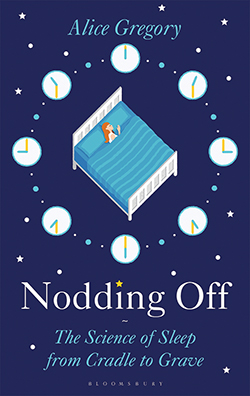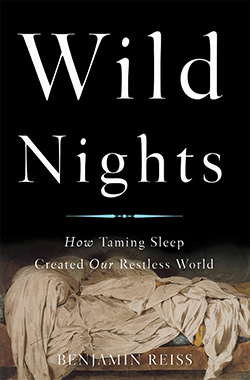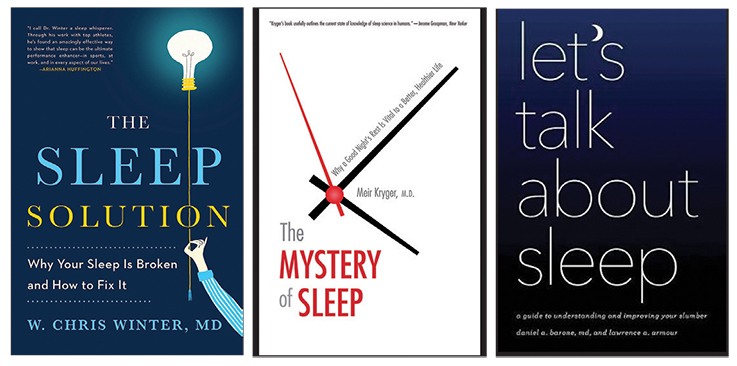The Science of Sleep | Collection Development
High quality and sufficient quantity sleep are both crucial to health and success—and can be harder than ever to get. The past two years have seen a boom in books about this precious commodity: those written by sleep researchers and specialists explaining the science and suggesting remedies and those about the philosophy, sociology, and/or history of sleep. Among them, these 23 titles promise to awaken most collections.
From an evolutionary standpoint, sleep doesn’t make sense. As they laid down to sleep each night, our hunter-gatherer ancestors placed themselves in a position of vulnerability to predator attack. Natural selection should have favored those individuals who required less sleep. Over the millennia, Homo sapiens should have developed the ability to survive and thrive on little to no sleep. Clearly, that didn’t happen. Sleep must serve some function that makes it worth the risk.
Why is sleep necessary? Sleep researchers have been working to answer this question since physiologist Nathaniel Kleitman opened the first sleep research lab in 1925. The brain waves associated with sleep were first measured by an electroencephalogram (EEG) in 1937. Rapid eye movement (REM) sleep, with its marked brain wave activity, was discovered in 1953, dispelling the notion that sleep is characterized by low levels of brain activity. Current evidence suggests that we repair cells, remove toxins, consolidate memory, process information, and much more while we sleep.
Yet as a society, we are sleep-deprived. According to the Centers for Disease Control and Prevention, 35.2 percent of all adults in the United States are short sleepers, averaging fewer than seven hours a night—the minimum recommended for optimum health. Short sleepers are predisposed to heart attack, coronary disease, stroke, asthma, chronic lung disease, arthritis, depression, chronic kidney disease, immune deficiency, lowered testosterone levels, and diabetes.
TODAY’S PERCEPTIONS
In today’s working world, however, lack of sleep is almost considered a virtue. Most people who brag about needing only four hours of sleep per night are kidding themselves; such people exist, but the ability to thrive on limited sleep is a genetic trait, and its prevalence is vanishingly small. It is well known that light from the screens of our devices interferes with sleep (by delaying melatonin release), yet we continue to check email and social media well into the evening and even after we’ve gone to bed.
In 1879, Thomas Edison filed a patent for his incandescent light bulb and began marketing it in 1880. In 1882, Edison developed the first commercial power utility in Manhattan. Our natural sleep patterns have been altered ever since. Artificial light allowed for the possibility of shift work, which continues to disrupt circadian rhythms and sleep patterns for millions of people. Research shows that we never adapt to shift work. The effect on the human brain of working rotating shifts for years results in marked cognitive decline, as demonstrated by studies conducted by the World Health Organization.
SLEEP DEPRIVATION
Numerous workplace catastrophes have been caused in part by fatigue: the near meltdown at the Three Mile Island nuclear plant in 1979; the Chernobyl nuclear disaster in 1986; the space shuttle Challenger explosion in 1986; the Exxon Valdez oil spill in 1989; and the crash of Korean Air 801 in 1997, which killed more than 200 people.
It is evident from some of the following works that organizations could save money and lives by addressing employees’ need for sleep. There are two types of books about sleep: those written by sleep researchers and specialists explaining the science and suggesting remedies and those about the philosophy, sociology, and/or history of sleep. The past two years have seen a boom in publishing in sleep science, as investigators have uncovered new and exciting details about how our brains function during sleep. There are also several excellent websites on the topic.
Starred titles (![]() ) are essential for most collections.
) are essential for most collections.
Rachel Owens is the Faculty Services and Collection Management Librarian, Daytona State College, Daytona Beach, FL. She has reviewed for LJ since 2012, and after years of practice, she is an accomplished sleeper
Sleep Science & Advice
Barone, Daniel A. with Lawrence A. Armour. Let’s Talk About Sleep: A Guide to Understanding and Improving Your Slumber. Rowman & Littlefield. Jan. 188p. ISBN 9781538103982
Barone, who is board certified in sleep medicine, offers advice to patients. Each chapter ends with a summary and an action plan; many concepts are illustrated with bullet points. Included are links to sleep websites and travel/jet lag information.

![]() Cralle, Terry & W. David Brown with William Cane. Sleeping Your Way to the Top: How To Get the Sleep You Need To Succeed. Sterling. 2016. 288p. ISBN 9781454918486. $19.95.
Cralle, Terry & W. David Brown with William Cane. Sleeping Your Way to the Top: How To Get the Sleep You Need To Succeed. Sterling. 2016. 288p. ISBN 9781454918486. $19.95.
Focusing on how sleep affects success in the workplace, the authors prove how absentee and accident rates are higher in those who don’t sleep well, arguing that “sufficient sleep is the dirty little secret of highly successful people.”
Dement, William C. The Promise of Sleep: A Pioneer in Sleep Medicine Explores the Vital Connection Between Health, Happiness, and a Good Night’s Sleep. Delacorte. 2000. 512p. ISBN 9780440509011. pap. $24.95.
This work by Dement, founder of the Sleep Research Center at California’s Stanford University, is most valuable as a history of sleep research from one of the subject’s primary pioneers. While the book is not up-to-date on sleep science, it will complete collections in need of background information.
Ehrnstrom, Colleen & Alisha L. Brosse. End the Insomnia Struggle: A Step-by-Step Guide To Help You Get to Sleep and Stay Asleep. New Harbinger. 2016. 232p. ISBN 9781626253438. pap. $24.95.
Written by clinical psychologists, this workbook guides readers through the development of a personalized sleep treatment plan and provides behavioral and cognitive strategies along with detailed instructions on how to use them. Readers can download worksheets from the website.
Foster, Russell & Leon Kreitzman. Circadian Rhythms: A Very Short Introduction. Oxford Univ. 2017. 144p. ISBN 9780198717683. pap. $11.95.
In a work that is ideal for academic libraries, the authors offer a scholarly discussion of the biological basis of circadian rhythms in all living organisms, including oscillations in gene activity and protein expression over the course of 24 hours, which ultimately influence behavior.
![]() Gregory, Alice. Nodding Off: The Science of Sleep from Cradle to Grave. Bloomsbury. Aug. 2018. 304p. ISBN 9781472946188. $28
Gregory, Alice. Nodding Off: The Science of Sleep from Cradle to Grave. Bloomsbury. Aug. 2018. 304p. ISBN 9781472946188. $28 .
.
British sleep researcher Gregory creates a valuable work that offers in-depth coverage of sleep in infancy, childhood, and adolescence. She also notes how sleep impacts mental health and includes an explanation of the genetic links to sleep patterns.
Huffington, Arianna. The Sleep Revolution: Transforming Your Life, One Night at a Time. Harmony: Crown. 2016. 400p. ISBN 9781101904008. $26.
The draw of this book is Huffington’s name; it may entice people to read about sleep disorders who wouldn’t otherwise. One section concentrates on naps at work, which is a perk the Huffington Post now provides to employees.
Kennedy, Janet Krone. The Good Sleeper: The Essential Guide to Sleep for Your Baby—and You. Holt. 2015. 304p. ISBN 9780805099430. pap. $18.
In this guide for new parents, clinical psychologist Kennedy provides steps on how to sleep through the night. Based on her expertise in treating sleep disorders, she organizes the book by the age of the child and provides tips for coping with colic.
![]() Kryger, Meir. The Mystery of Sleep: Why a Good Night’s Rest Is Vital to a Better, Healthier Life. Yale Univ. 2017. 344p. ISBN 9780300224085. $28.
Kryger, Meir. The Mystery of Sleep: Why a Good Night’s Rest Is Vital to a Better, Healthier Life. Yale Univ. 2017. 344p. ISBN 9780300224085. $28.
Kryger is the chief author of the most widely used sleep medicine textbook, Principles and Practice of Sleep Medicine. Here, his focus is on the impact of sleep disorders on family and society, with clear explanations for patients about how to describe symptoms to doctors and for doctors as to what questions to ask when taking a history.
![]() Walker, Matthew. Why We Sleep: Unlocking the Power of Sleep and Dreams. Scribner. 2017. 368p. ISBN 9781501144318. $27.
Walker, Matthew. Why We Sleep: Unlocking the Power of Sleep and Dreams. Scribner. 2017. 368p. ISBN 9781501144318. $27.
Walker, a sleep researcher, provides a thorough explanation of sleep science for lay readers, with details about REM, non-REM, and why we need both. He also explores how sleep affects society, at home, school, and work.
![]() Winter, W. Chris. The Sleep Solution: Why Your Sleep Is Broken and How To Fix It. Berkley. 2017. 272p. ISBN 9780399583605. $26.
Winter, W. Chris. The Sleep Solution: Why Your Sleep Is Broken and How To Fix It. Berkley. 2017. 272p. ISBN 9780399583605. $26.
Winter, a board-certified sleep medicine specialist, writes an entertaining and highly readable handbook for those living with sleep disorders. This practical guide is full of humor and empathy.
Sleep History & More
Bulkeley, Kelly. An Introduction to the Psychology of Dreaming. 2d ed. ABC-CLIO. 2017. 160p. ISBN 9781440857065. $37.
Psychologist of religion Bulkeley introduces readers to the place of dreams in psychological thought and strives to answer three questions using neuroscience research: How are dreams formed? What is the function of dreams? What do they mean?
 Reiss, Benjamin. Wild Nights: How Taming Sleep Created Our Restless World. Basic: Perseus. 2017. 320p. ISBN 9780465061952.
Reiss, Benjamin. Wild Nights: How Taming Sleep Created Our Restless World. Basic: Perseus. 2017. 320p. ISBN 9780465061952.
Reiss provides a social history of sleep, with each chapter exploring a different aspect of modern sleep and its costs. His primary focus is on the concept of sleep security—having the time, space, and security to sleep as you choose, which is not always available to those experiencing homelessness or poverty. The work also discusses slavery’s impact on sleep.
Websites
American Sleep Apnea Association;
Promotes awareness of sleep apnea and advocates for sleep apnea patients. Includes a CPAP assistance program, a section on advocacy, links to clinical trials, information for patients and clinicians, and a discussion forum for the sleep apnea community.
Healthy Sleep;
From the Division of Sleep Medicine at Harvard Medical School comes this resource that features an interactive time line of the history of sleep knowledge and research.
National Sleep Foundation;
An educational site with sections on sleep disorders along with related topics such as drowsy driving. Included is a searchable directory of sleep professionals who are members of the foundation as well as continuing education resources for professionals.
Restless Legs Syndrome Foundation;
Restless Legs Syndrome (RLS) affects seven to eight percent of the population and often causes difficulty in falling or staying asleep. The site includes information on RLS, treatment, and research and clinical trials. There’s also a section for health-care professionals.
Sleep and Sleep Disorders, Centers for Disease Control
The CDC’s section on sleep offers background information on sleep-related disorders as well as fact sheets, data and statistics, publications, materials for professionals, and related links.
Sleepio: Digital Sleep Improvement Program;
This program, led by a group of sleep scientists in the UK, is digital sleep intervention that includes cognitive behavioral therapy. Participants set goals, complete an in-depth sleep questionnaire, and receive a personalized sleep program.
This article was originally published in Library Journal's September 1, 2018 issue
RELATED
ALREADY A SUBSCRIBER? LOG IN
We are currently offering this content for free. Sign up now to activate your personal profile, where you can save articles for future viewing










Add Comment :-
Comment Policy:
Comment should not be empty !!!